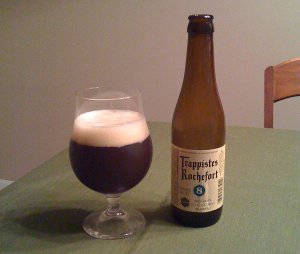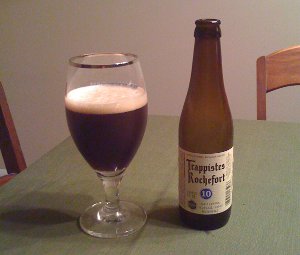In 2009, a crack commando unit was sent to prison by a military court for a crime they didn't commit. These men and women promptly escaped from a maximum-security stockade to the West Chester underground. Today, still wanted by the government, they survive as drinkers of craft beer. If you have a problem... if no one else can help... and if you can find them a local BYOB in which to meet... maybe you can hire... The Beer Club Team.
Well, that didn't work as well as it did in my head, but I'm going to leave it there as a reminder to myself that my stupid references aren't as funny as I think. Take that, self! What was I talking about? Oh yeah, Beer Club, a gathering of beer minded folks from my work. We meet up once a month at a local BYOB and sample all sorts of beers. Decent turnout tonight, and some great beers too:
Half remembered thoughts on each beer are below. For posterity, you understand. In order of drinking (not necessarily the order depicted above:
- Harpoon UFO White - I could have sworn we've had this at beer club before, but I can't find any reference to it... Holy coriander, Batman! Very powerfully spiced for a simple wheat beer, but it made for a nice, bland start to the evening. B
- Kaedrin Saison - Man, this thing is drinking perfect right now! Huge carbonation, spicy, crisp, and dry. Great with food, and I'm really disappointed that I only have a couple bottles of this left. This may end up being one of my better beers of all time. B+ or A- material here.
- Kaedrôme Saison - Alas, this has not quite carbonated itself so well just yet. Disappointing. I had one last week, and it seemed like it was doing well, but nope, tonight's was lower carbonated than the last one I had. Weird. I'll give it a few more weeks before opening another (it seems that the regular saison is peaking right now, after several months) and leave it at that for now...
- Ken's Homebrewed Winter Warmer - Very solid example of the style, very well spiced with cinnamon, nutmeg, and vanilla, it came out really smooth and almost creamy, with that spicy kick. I really enjoyed this, even more than the other Winter Warmer/Holiday beers of the night. B+
- Sly Fox Christmas Ale - Another winter warmer, and one I look forward to every year. Alas, they change up the recipe every year, and I have to admit, I'm not in love with this year's version. It's fine, to be sure, but not as good as previous years (or Ken's homebrew!) B-
- Lexington Kentucky Bourbon Barrel Ale - It's amazing how little repetition there is in beer club. I can probably count on one hand the number of times that someone has brought a beer that's been at beer club before... This one was just at beer club back in September, which wouldn't be that bad except that no one really likes this beer! It's so thin and the bourbon barrel treatment doesn't really come through in any meaningful way (it's got some of that bourbon flavor, but it feels watered down and just flat). It's not a hideous abomination, but it's not particularly good either. C
- Trappistes Rochefort 6 - A classic that I've already reviewed, and a welcome relief from the previous beer!
- Affligem Noël - This was one of my favorite beers when I started the blog... but I didn't respond quite so well this time around. Not sure if it's just the context of beer club and a beleaguered palate, or if this really isn't as good as I remember. The balance is certainly off here, a little boozy, not enough malt and spice to counteract that. It's certainly not bad at all, and I do still really enjoy it, but perhaps not as much as I originally did... Let's call it a B or B+ now.
- Southern Tier Phin & Matt's Extraordinary Ale - A late arrival, this perhaps should have been opened earlier in the night... but even then, I suspect this would underwhelm. C+
- Boulevard Bourbon Barrel Quad - Dana and I shop at the same beer store. She shared hers, I greedily drank mine by myself. As I rated on Monday, B+
- Stone Suede Imperial Porter - It's a fine porter, light roast, some complexity from those weird flower and jasmine adjuncts, but ultimately this is a beer that doesn't really float my boat. It's fine, I could probably take one down on my own, but I'm glad I was trying it in a tasting setting... B
- Goose Island Bourbon County Brand Stout - Another Dana special, I'm really glad she brought this... mostly because it's just awesome beer (that I've reviewed before). Still an A
- Goose Island Bourbon County Brand Coffee Stout - And this one was my contribution for the night. I had this last year and loved it, but it had aged for a few months before I cracked it open. This year, I had one fresh and thought I absolutely had to share this. I don't particularly love coffee, and this thing is a huge coffee bomb. It's amazing how much the coffee fades in the beer after a few months (I know the coffee is different every year, so maybe that's a factor this year too, but it's still dominated by coffee, to the point where I can barely get the bourbon barrel out of this, though it is there). Since some members of beer club are big coffee fans, I thought I should share it while it's fresh. It did not disappoint.
- Fort Collins 1900 Amber Lager - I will refrain from talking much about this because after the Bourbon County, this was basically like water. A simple palate cleanser. That being said, it does not seem like my kinda thing...



